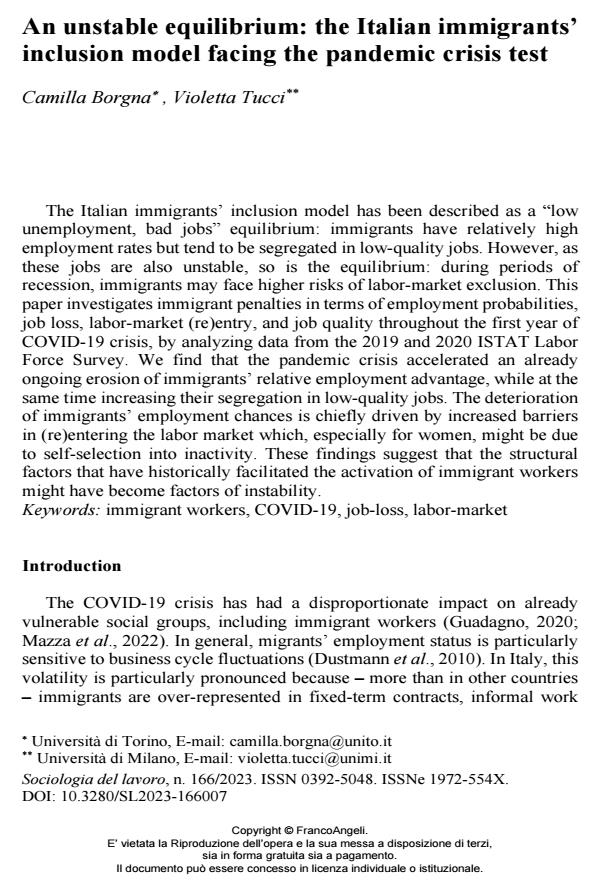An unstable equilibrium: the Italian immigrants’ inclusion model facing the pandemic crisis test
Titolo Rivista SOCIOLOGIA DEL LAVORO
Autori/Curatori Camilla Borgna, Violetta Tucci
Anno di pubblicazione 2023 Fascicolo 2023/166
Lingua Inglese Numero pagine 28 P. 155-182 Dimensione file 644 KB
DOI 10.3280/SL2023-166007
Il DOI è il codice a barre della proprietà intellettuale: per saperne di più
clicca qui
Qui sotto puoi vedere in anteprima la prima pagina di questo articolo.
Se questo articolo ti interessa, lo puoi acquistare (e scaricare in formato pdf) seguendo le facili indicazioni per acquistare il download credit. Acquista Download Credits per scaricare questo Articolo in formato PDF

FrancoAngeli è membro della Publishers International Linking Association, Inc (PILA)associazione indipendente e non profit per facilitare (attraverso i servizi tecnologici implementati da CrossRef.org) l’accesso degli studiosi ai contenuti digitali nelle pubblicazioni professionali e scientifiche
The Italian immigrants’ inclusion model has been described as a "low unemployment, bad jobs" equilibrium: immigrants have relatively high employment rates but tend to be segregated in low-quality jobs. However, as these jobs are also unstable, so is the equilibrium: during periods of recession, immigrants may face higher risks of labor-market exclusion. This paper investigates immigrant penalties in terms of employment probabilities, job loss, labor-market (re)entry, and job quality throughout the first year of COVID-19 crisis, by analyzing data from the 2019 and 2020 ISTAT Labor Force Survey. We find that the pandemic crisis accelerated an already ongoing erosion of immigrants’ relative employment advantage, while at the same time increasing their segregation in low-quality jobs. The deterioration of immigrants’ employment chances is chiefly driven by increased barriers in (re)entering the labor market which, especially for women, might be due to self-selection into inactivity. These findings suggest that the structural factors that have historically facilitated the activation of immigrant workers might have become factors of instability.
Parole chiave:immigrant workers, COVID-19, job-loss, labor-market
- La segmentazione del mercato del lavoro migrante in italia: dinamiche durante e dopo la pandemia da Covid-19 Antonio Sanguinetti, in ECONOMIA E SOCIETÀ REGIONALE 1/2024 pp.11
DOI: 10.3280/ES2024-001002
Camilla Borgna, Violetta Tucci, An unstable equilibrium: the Italian immigrants’ inclusion model facing the pandemic crisis test in "SOCIOLOGIA DEL LAVORO " 166/2023, pp 155-182, DOI: 10.3280/SL2023-166007